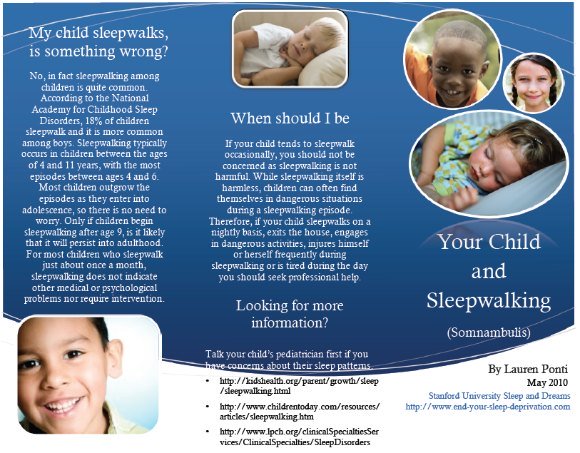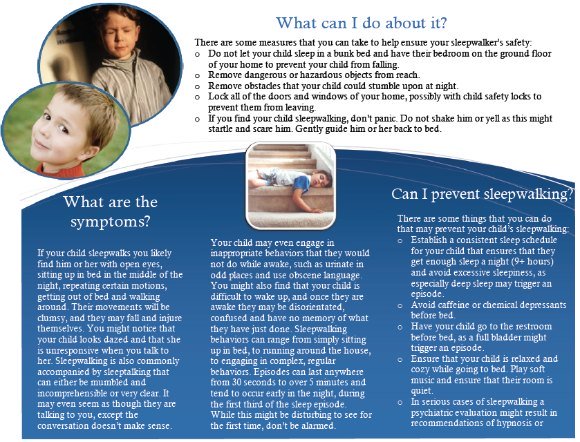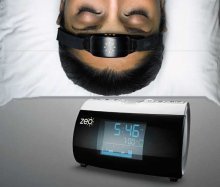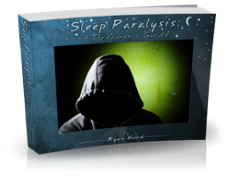
| Connect & Subscribe |
Sleepwalking In Children Brochure
An Outreach Project by Lauren Ponti | Return To Outreach Projects 2010
The following is a student-made brochure created for Stanford Sleep and Dreams. If it is difficult to read using the images, you may view the full text here.
Also feel free to download this brochure for distributional or general information purposes. Please refer to our privacy policy for our relevant disclaimers.


My Child Sleepwalks, Is Something Wrong?
No, in fact sleepwalking in children is quite common. According to the National Academy for Childhood Sleep Disorders, 18% of children sleepwalk and it is more common among boys. Sleepwalking typically occurs in children between the ages of 4 and 11 years, with the most episodes between ages 4 and 6. Most children outgrow the episodes as they enter into adolescence, so there is no need to worry. Only if children begin sleepwalking after age 9, is it likely that it will persist into adulthood. For most children who sleepwalk just about once a month, sleepwalking does not indicate other medical or psychological problems nor require intervention.
What Are The Symptoms?
If your child sleepwalks you likely find him or her with open eyes, sitting up in bed in the middle of the night, repeating certain motions, getting out of bed and walking around. Their movements will be clumsy, and they may fall and injure themselves. You might notice that your child looks dazed and that she is unresponsive when you talk to her. Sleepwalking is also commonly accompanied by sleeptalking that can either be mumbled and incomprehensible or very clear. It may even seem as though they are talking to you, except the conversation doesn't make sense.
Your child may even engage in inappropriate behaviors that they would not do while awake, such as urinate in odd places and use obscene language. You might also find that your child is difficult to wake up, and once they are awake they may be disorientated, confused and have no memory of what they have just done. Sleepwalking behaviors can range from simply sitting up in bed, to running around the house, to engaging in complex, regular behaviors. Episodes can last anywhere from 30 seconds to over 5 minutes and tend to occur early in the night, during the first third of the sleep episode. While this might be disturbing to see for the first time, don't be alarmed.
What Can I Do About It?
There are some measures that you can take to help ensure your sleepwalker's safety:
- Do not let your child sleep in a bunk bed and have their bedroom on the ground floor of your home to prevent your child from falling.
- Remove dangerous or hazardous objects from reach.
- Remove obstacles that your child could stumble upon at night.
- Lock all of the doors and windows of your home, possibly with child safety locks to prevent them from leaving.
- If you find your child sleepwalking, don't panic. Do not shake him or yell as this might startle and scare him. Gently guide him or her back to bed.
Can I Prevent Sleepwalking?
There are some things that you can do that may prevent your child's sleepwalking:
- Establish a consistent sleep schedule for your child that ensures that they get enough sleep a night (9+ hours) and avoid excessive sleepiness, as sleep deprivation may help trigger an episode.
- Avoid caffeine or chemical depressants before bed.
- Have your child go to the restroom before bed, as a full bladder might trigger an episode.
- Ensure that your child is relaxed and cozy while going to bed. Play soft music and ensure that their room is quiet.
- In serious cases of sleepwalking a psychiatric evaluation might result in recommendations of hypnosis or prescriptions of Benzodiazepines to prevent episodes.
When Should I Be Concerned?
If your child tends to sleepwalk occasionally, you should not be concerned as sleepwalking is not harmful. While sleepwalking itself is harmless, children can often find themselves in dangerous situations during a sleepwalking episode. Therefore, if your child sleepwalks on a nightly basis, exits the house, engages in dangerous activities, injures himself or herself frequently during sleepwalking or is tired during the day you should seek professional help.
Looking For More Information?
Talk with your child's pediatrician first if you have concerns about their sleep patterns. In addition, here's some web resources that may prove valuable:
http://kidshealth.org/parent/growth/sleep/sleepwalking.html
http://www.lpch.org/clinicalSpecialtiesServices/ClinicalSpecialties/SleepDisorders/sleepDisorders.html
Return from Sleepwalking In Children to All Outreach Projects 2010
Get more information on sleepwalking
Learn more about sleep than 99% of the world with our Sleep Essentials Mini-Guide
About This Site
Welcome! This site is continuously being created by students of Dr. William C. Dement's Sleep And Dreams course at Stanford University.
We made this site as a call to action for people all over the world to live healthier, happier, safer, and more productive lives by learning about their own sleep. We have faith that reading the information provided on this site will motivate you to be smart about your sleep deprivation and strategic about your alertness in order to live life to your fullest, most energetic potential.
In fact, we challenge you to do so! What do you say, are you up for the challenge?
Interviews With Sleep Specialists: Insights Into the Worlds of Sleep Medicine & Sleep Business
America's Most Dangerous Disorder: What Is Sleep Apnea Doing To Your Sleep?
Sleep Debt: How Much More Will You Achieve When You Reduce Yours?
The Stages Of Sleep: The Journey Through The Night
Delayed Sleep Phase: You Want To Sleep But You're Not Tired Yet
Paralyzed at Night: Is Sleep Paralysis Normal?
Sleep In Words: Smart, Strange, and Funny Quotes About Sleep
Sleep Disorders In Children: What's Keeping Your Child From A Full Night's Rest?
Attacks of Pavor Nocturnus (a.k.a. Sleep Terrors, Night Terrors, or Incubus Attacks)
The Stanford Sleep Book
Dr. Dement's pioneering textbook has been the core text for Sleep and Dreams since 1980, but it has just recently been made available to the wider public for the first time.
In it you'll find a more detailed account of the most important things you need to know about sleep, alertness, dreams, and sleep disorders. Studies, statistics, plus plenty of Dr. Dement's classic anecdotes painting the history of sleep medicine.
Preface | Intro | Contents | Get A Copy
More Sleep Resources
The Zeo
A revolution in personal sleep tracking, the Zeo is a wireless headband that transmits your brainwaves in realtime to a dock (pictured here) or your smartphone. The result? You can wake up and see exactly what stages of sleep you were in during the night! Unprecedented personalized sleep knowledge.
Sleep Paralysis: A Dreamer's Guide
Ever woken up paralyzed? A surprising number of us have, believe it or not. But few know the actual causes of this phenomenon, and fewer still how to exert control over it. Dream researcher and sleep paralysis expert Ryan Hurd shares breakthrough insights into how to do just that.
Important Disclaimer
Please Note:
The information found on this page and throughout this site is intended for general information purposes only. While it may prove useful and empowering, it is NOT intended as a substitute for the expertise and judgments of healthcare practitioners.
For more info, see our
Terms of Use.









